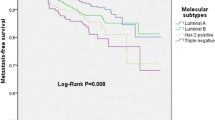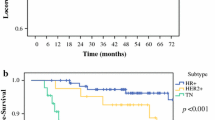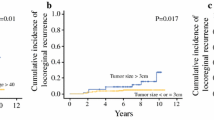Abstract
Background
Postmastectomy radiation (PMRT) in T1–T2 tumors with 1–3 positive axillary lymph nodes (ALNs) is controversial. Impact of molecular subtype (MST) on locoregional recurrence (LRR) and PMRT benefit is uncertain. We examined the association between MST and LRR, recurrence-free survival (RFS), and overall survival (OS), in T1–T2 tumors with 1–3 positive ALNs.
Methods
From an institutional database, we identified mastectomy patients with 1–3 positive ALNs between 1995 and 2006. Patients who received neoadjuvant chemotherapy, had T3–T4 tumors, or ≥4 positive ALNs were excluded. MST was defined as: hormone receptor (HR)+/HER2−(luminal A/B), HR+/HER2+(luminal HER2), HR−/HER2+(HER2), and HR−/HER2−(basal). Kaplan–Meier method and Cox regression analysis were used to examine association between MST and LRR, RFS, and OS.
Results
This study included 884 patients (700 no PMRT, 141 PMRT): 72.8 % luminal A/B, 7.8 % luminal HER2, 6.8 % HER2, and 12.6 % basal. Median follow-up was 6.3 years; 39 LRRs occurred. Luminal A/B subtype had the smallest tumors (p = 0.03), lowest intraductal component (p = 0.01), histologic grade (p < 0.0001), lymphovascular invasion (LVI) (p = 0.008), and multifocality/multicentricity (p = 0.02). On univariate analyses, there was no association between MST and LRR. MST was associated with RFS and OS; the basal and HER2 subtype had the lowest RFS (p = 0.0002) and OS (p < 0.0001). On multivariate analysis, only age ≤50 years (p = 0.003) and presence of LVI (p = 0.0003) were predictive of LRR; MST was not (p = 0.38).
Conclusion
In patients with T1–T2 breast cancer and 1–3 positive lymph nodes who did not receive PMRT, MST was not an independent predictor of LRR and may not be useful in selecting PMRT candidates in that group.



Similar content being viewed by others
Reference
Overgaard M, Hansen PS, Overgaard J, Rose C, Andersson M, Bach F, et al. Postoperative radiotherapy in high-risk premenopausal women with breast cancer who receive adjuvant chemotherapy. Danish Breast Cancer Cooperative Group 82b Trial. N Engl J Med. 1997;337:949–55.
Ragaz J, Jackson SM, Le N, Plenderleith IH, Spinelli JJ, Basco VE, et al. Adjuvant radiotherapy and chemotherapy in node-positive premenopausal women with breast cancer. N Engl J Med. 1997;337:956–62.
Clarke M, Collins R, Darby S, Davies C, Elphinstone P, Evans E, et al. Effects of radiotherapy and of differences in the extent of surgery for early breast cancer on local recurrence and 15-year survival: an overview of the randomised trials. Lancet. 2005;366:2087–106.
Overgaard M, Jensen MB, Overgaard J, Hansen PS, Rose C, Andersson M, et al. Postoperative radiotherapy in high-risk postmenopausal breast-cancer patients given adjuvant tamoxifen: Danish Breast Cancer Cooperative Group DBCG 82c randomised trial. Lancet. 1999;353:1641–8.
Recht A, Gray R, Davidson NE, Fowble BL, Solin LJ, Cummings FJ, et al. Locoregional failure 10 years after mastectomy and adjuvant chemotherapy with or without tamoxifen without irradiation: experience of the Eastern Cooperative Oncology Group. J Clin Oncol. 1999;17:1689–700.
Sharma R, Bedrosian I, Lucci A, Hwang RF, Rourke LL, Qiao W, et al. Present-day locoregional control in patients with t1 or t2 breast cancer with 0 and 1–3 positive lymph nodes after mastectomy without radiotherapy. Ann Surg Oncol. 2010;17:2899–908.
Tendulkar RD, Rehman S, Shukla ME, Reddy CA, Moore H, Budd GT, et al. Impact of postmastectomy radiation on locoregional recurrence in breast cancer patients with 1–3 positive lymph nodes treated with modern systemic therapy. Int J Radiat Oncol Biol Phys. 2012;83:e577–81.
Jagsi R, Pierce L. Postmastectomy radiation therapy for patients with locally advanced breast cancer. Semin Radiat Oncol. 2009;19:236–43.
Truong PT, Olivotto IA, Kader HA, Panades M, Speers CH, Berthelet E. Selecting breast cancer patients with T1–T2 tumors and 1–3 positive axillary nodes at high postmastectomy locoregional recurrence risk for adjuvant radiotherapy. Int J Radiat Oncol Biol Phys. 2005;61:1337–47.
Sorlie T, Perou CM, Tibshirani R, Aas T, Geisler S, Johnsen H, et al. Gene expression patterns of breast carcinomas distinguish tumor subclasses with clinical implications. Proc Natl Acad Sci USA. 2001;98:10869–74.
Sotiriou C, Neo SY, McShane LM, et al. Breast cancer classification and prognosis based on gene expression profiles from a population-based study. Proc Natl Acad Sci USA. 2003;100:10393–8.
Van’t Veer LJ, Dai H, van de Vijver MJ, He YD, Hart AA, Mao M, et al. Gene expression profiling predicts clinical outcome of breast cancer. Nature. 2002;415:530–536.
Recht A, Edge SB, Solin LJ, Robinson DS, Estabrook A, Fine RE, et al. Postmastectomy radiotherapy: clinical practice guidelines of the American Society of Clinical Oncology. J Clin Oncol. 2001;19:1539–69.
National Comprehensive Cancer Network (NCCN) Guidelines Version 1.2013, Clinical Practice guidelines in Oncology- Breast Cancer. http://www.nccn.org/professionals/physician_gls/pdf/breast.pdff. Accessed 9 Feb 2013.
Dragun AE, Huang B, Gupta S, Crew JB, Tucker TC. One decade later: trends and disparities in the application of post-mastectomy radiotherapy since the release of the American Society of Clinical Oncology clinical practice guidelines. Int J Radiat Oncol Biol Phys. 2012;83:e591–6.
Kyndi M, Sorensen FB, Knudsen H, Overgaard M, Nielsen HM, Overgaard J, et al. Estrogen receptor, progesterone receptor, HER-2, and response to postmastectomy radiotherapy in high-risk breast cancer: the Danish Breast Cancer Cooperative Group. J Clin Oncol. 2008;26:1419–26.
Nguyen PL, Taghian AG, Katz MS, Niemierko A, Abi Raad RF, Boon WL, et al. Breast cancer subtype approximated by estrogen receptor, progesterone receptor, and HER-2 is associated with local and distant recurrence after breast-conserving therapy. J Clin Oncol. 2008;26:2373–2378.
Millar EK, Graham PH, O’Toole SA, McNeil CM, Browne L, Morey AL, et al. Prediction of local recurrence, distant metastases, and death after breast-conserving therapy in early-stage invasive breast cancer using a five-biomarker panel. J Clin Oncol. 2009;27:4701–8.
Voduc KD, Cheang MC, Tyldesley S, Gelmon K, Nielsen TO, Kennecke H, et al. Breast cancer subtypes and the risk of local and regional relapse. J Clin Oncol. 2010;28:1684–91.
Wang SL, Li YX, Song YW, Wang WH, Jin J, Liu YP, et al. Triple-negative or HER2-positive status predicts higher rates of locoregional recurrence in node-positive breast cancer patients after mastectomy. Int J Radiat Oncol Biol Phys. 2011;80:1095–101.
Dominici LS, Mittendorf EA, Wang X, Liu J, Kuerer HM, Hunt KK, et al. Implications of constructed biologic subtype and its relationship to locoregional recurrence following mastectomy. Breast Cancer Res. 2012;14:R82.
Romond EH, Perez EA, Bryant J, Suman VJ, Geyer CE Jr, Davidson NE, et al. Trastuzumab plus adjuvant chemotherapy for operable HER2-positive breast cancer. N Engl J Med. 2005;353:1673–84.
Nielsen TO, Hsu FD, Jensen K, Cheang M, Karaca G, Hu Z, et al. Immunohistochemical and clinical characterization of the basal-like subtype of invasive breast carcinoma. Clin Cancer Res. 2004;10:5367–74.
Carey LA, Perou CM, Livasy CA, Dressler LG, Cowan D, Conway K, et al. Race, breast cancer subtypes, and survival in the Carolina Breast Cancer Study. JAMA. 2006;295:2492–502.
Acknowledgements
This study was funded in part through NIH/NCI Cancer Center Support Grant P30 CA008748, the authors have no conflicts of interest to disclose, and the findings contained in this manuscript were presented in part at the 2013 Society of Surgical Oncology Annual Cancer Symposium on March 8, 2013.
Author information
Authors and Affiliations
Corresponding author
Rights and permissions
About this article
Cite this article
Moo, TA., McMillan, R., Lee, M. et al. Impact of Molecular Subtype on Locoregional Recurrence in Mastectomy Patients with T1–T2 Breast Cancer and 1–3 Positive Lymph Nodes. Ann Surg Oncol 21, 1569–1574 (2014). https://doi.org/10.1245/s10434-014-3488-x
Received:
Published:
Issue Date:
DOI: https://doi.org/10.1245/s10434-014-3488-x




